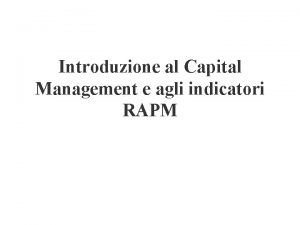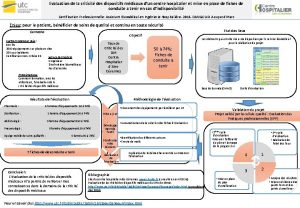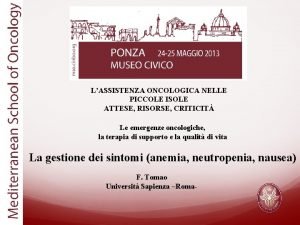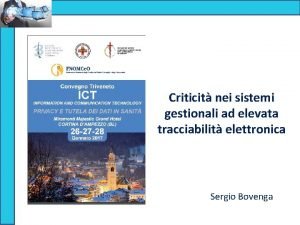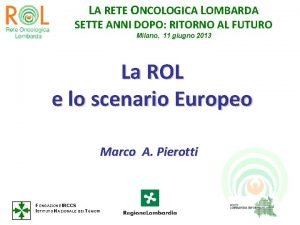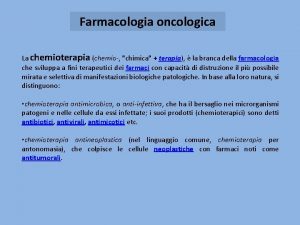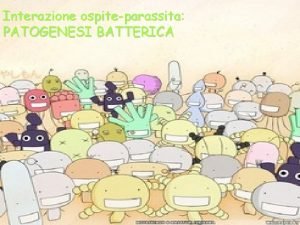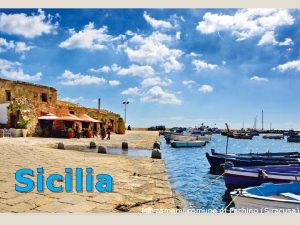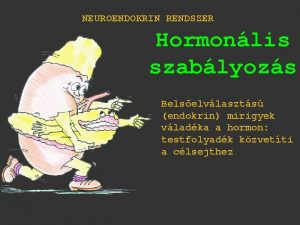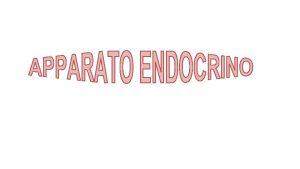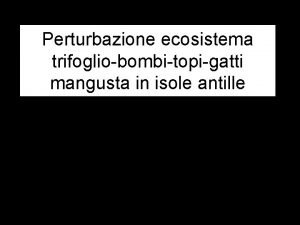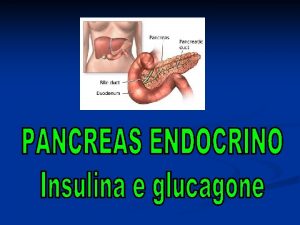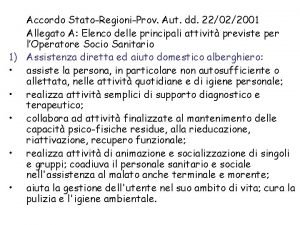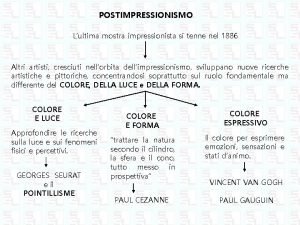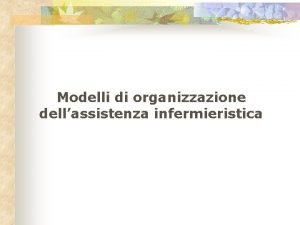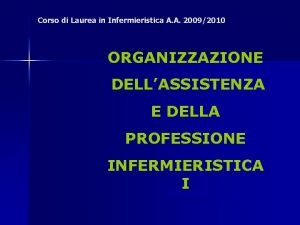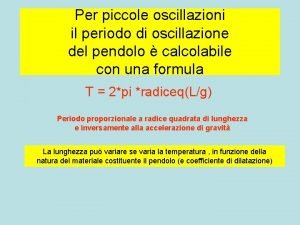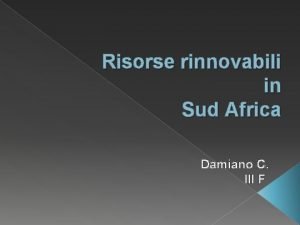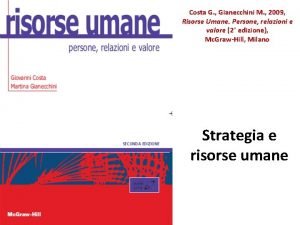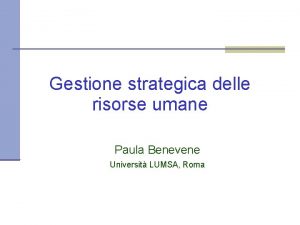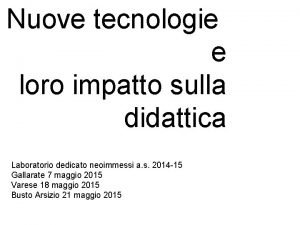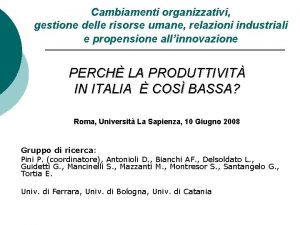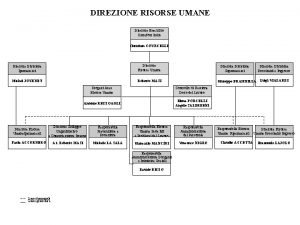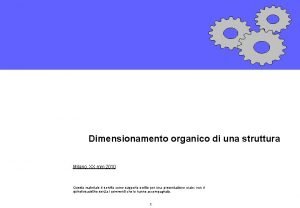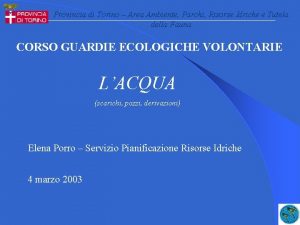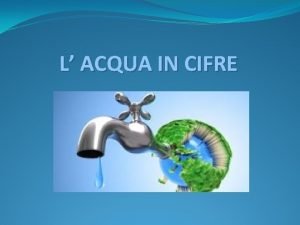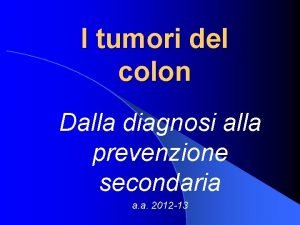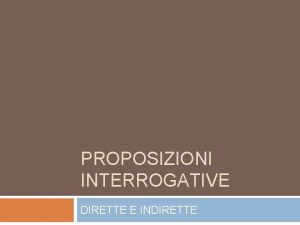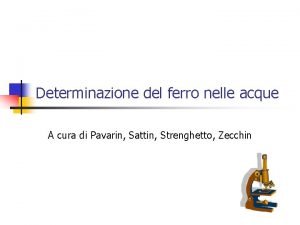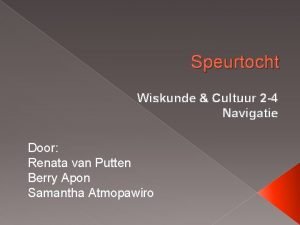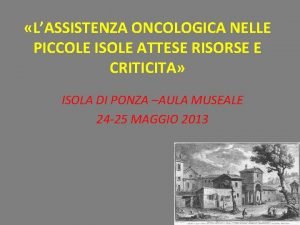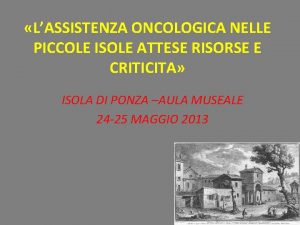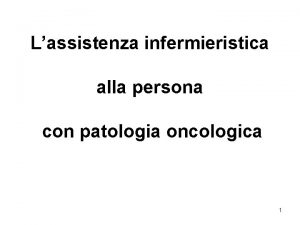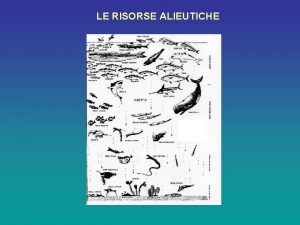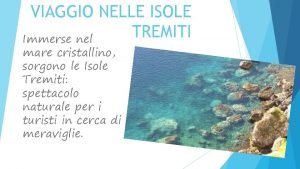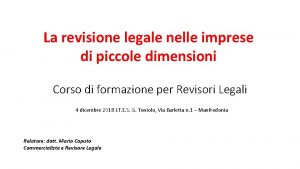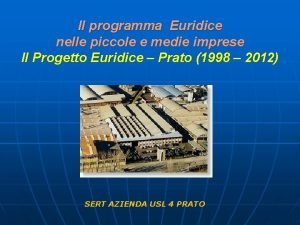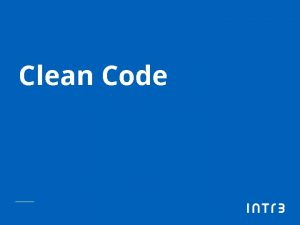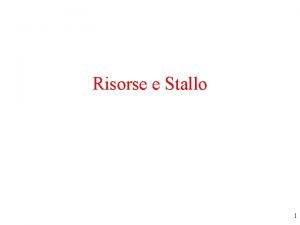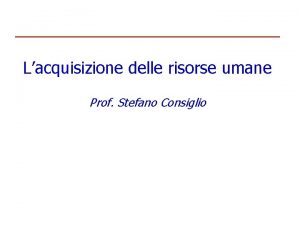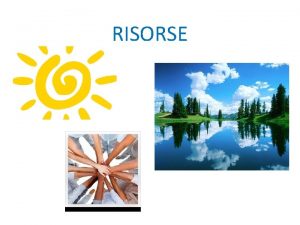LASSISTENZA ONCOLOGICA NELLE PICCOLE ISOLE ATTESE RISORSE CRITICIT
























































- Slides: 56

L’ASSISTENZA ONCOLOGICA NELLE PICCOLE ISOLE ATTESE, RISORSE, CRITICITÀ Le emergenze oncologiche, la terapia di supporto e la qualità di vita La gestione dei sintomi (anemia, neutropenia, nausea) F. Tomao Università Sapienza –Roma-

1960 Supportive Care Dott. Cecily Sanders “Treatment administered with the intent to maximize quality of life without a specific antineoplastic regimen, ” (antibiotics, analgesics, antiemetics, thoracentesis, pleurodesis, blood transfusions, nutritional support, and focal external-beam radiation for control of pain, cough, dyspnea, or hemoptysis) Jassem et al. J Clin Oncol 2008

Supportive Care Toxicity Targets v. Hematologic • Myelosuppression v. Gastrointestinal • Nausea/vomiting • Constipation/diarrhea • Mucositis v. Cardiovascular • Thrombosis • Cardiac v. Neurologic • Peripheral neuropathy • Cognitive v Pulmonary v. Renal v. Cutaneous • Alopecia • Rash

Anemia Hgb < 14 g/dl Hgb < 12 g/dl Grade Toxicity NCI Score WHO Score 0 None 12 -16 g/d. L >11 1 Mild 10 g/d. L-LLN 9. 5 -10 g/d. L 2 Moderate 8 -10 g/d. L 8 -9. 4 g/d. L 3 Severe 6. 5 -7. 9 g/d. L 4 life-threatening or disabling <6. 5 g/d. L

Anemia in cancer patients: the ECAS study Prospective study 15. 367 pts 748 cancer centres, 24 countries Hgb <12. 0 g/dl=49. 1% Ludwig et al. Eur. J. Cancer 2004

Causes and Effects of Cancer – related Anemia Causes Effects Disease – related factors 1 Decrease in QOL 2, 3, 4 Folate, Vit B 12, Iron deficiency 1 Increase in transfusion rates 5 Anemia of chronic disease 1 Probable decrease in survival 6, 7, 8 Chemotherapy 1 1 - Grotto, Med Oncol, 2008; 2 - Gabrilove, JCO 2001; 3 - Littlewood, JCO 2001; 4 - Cella D. Ann Oncol, 2003; 5 -Benoist S. , Surgery, 2001; 6 - Caro, Cancer 2001; 7 - Waters, JCO 2002; 8 - Fuso L. Gynecol Oncol 2005

Incidence of anemia associated with chemotherapeutic agents and regimens Agent Grade 1 -2 (%) Grade 3 -4 (%) Cancer Cisplatin NR 11 H&N Docetaxel 73 -85 58 -60 2 -10 27 -42 NSCLC Ovarian 5 -FU NR 50 -54 11 5 -8 H&N Colorectal Paclitaxel 93 7 Breast Topotecan NR 67 32 32 SCLC Ovarian Vinorelbine 67 -71 5 -14 Breast Regimen Grade 1 -2 (%) Grade 3 -4 (%) Cancer Cisplatin-Ciclophosphamide 43 9 Ovarian Cisplatin-Etoposide 59 16 -55 NSCLC VIP NR 52 SCLC 5 -FU-Carboplatin 93 7 H&N CHOP 49 17 NHL Paclitaxel-Doxorubicin 78 -84 8 -11 Breast Paclitaxel-Carboplatin 10 -59 5 -34 NSCLC

Treatments for Anemia v Transfusions v ESAs v Non ESAs: - Fe++ - Lattoferrina v Dietary supplementation

Benefits and Risks of RBC Transfusions Quick enhancement of HB level: 1 U of RBC (circa 300 cc) • Graft-versus-host disease • Transfusion Related Acute Lung Injury (TRALI) • Non emolitic fever related Reactions • Acute Emolisis • Allergy • Anafilaxis 1/g/d. L icrease in 1 hour • More peri-operative infections • Infectious (HIV, HBV, HCV, HTLV West Nile, Bacteria) • More relapses • Worst prognosis Upile, T, et al. Clinical Advances in Hematology & Oncology, 2009

Use of ESAs in cancer patients N° of publications about the use of ESAs in cancer patients 4000 3500 3000 2500 2000 N° of publications about the use of ESAs in cancer patients 1500 1000 500 2 2 01 -2 02 20 -2 92 99 19 -1 00 2 2 82 19 -1 98 2 72 19 62 -1 97 2 96 19 52 -1 95 19 -1 42 19 19 32 -1 94 2 2 0 BLOOD TRASFUSION RATE: ESAs significantly reduced the RR of RBC transfusions (RR 0. 64; 95% CI 0. 60 to 0. 68, 42 trials, n = 6, 510). Pubmed Bohlius J et al. Cochrane Database Syst Rev, 2006

r. Hu. EPOs TYPE OF SYNTETIC ERYTHROPOIETIN COMMERCIAL NAME MOLECULARE STRUCTURE HALF LIFE EPOETIN α Eprex® Epogen® Procrit® aa sequence identical to 7– 8 h EPOETIN β Neo. Recormon® Higher MW than 4 – 12 h DARBEPOETIN α Aranesp® 2 N- lynked glycosylation 24 h EPOETIN δ Dynepo® Human- type 9 – 13 h C. E. R. A. (Continuous MIRCERA® Integration of amide 135 h Erythropoietin Receptor Activator) endogenous Epo. Different composition and arrangements of the sugar moieties. Epoetin α Lower number of sialylated glycan residues sites, above and beyond the 3 normally present in endogenous Epo glycosylation profile (engineered in human fibrosarcoma cell line HT 1080) bonds between amino group Integration of MPGBA Bunn H. F. , Blood, 2007; Deicher R. et al. , Drugs, 2004; Osterborg, bjh, 2007; Llop E. et al. , Analytical Biochemistry, 2008

Use of ESAs in cancer patients Epo Hb (g/dl) 12 Transfusion 10 8 6 transfusions 4 0 30 60 90 Österborg. Med Oncol 1998; 15 (Suppl 1): S 47– 9 Ludwig et al. N Engl J Med 1990; 322: 1693– 9 120 150 180 210

ESAs: improvement in CRF. Haemopoetic growth factors versus no intervention. Minton O et al. Cochrane Database Syst Rev 2008 Studies with FACT F.

“Is it all over for erythropoietin? ” The role of erythropoietin receptors on the tumour cell surface Risk of Thromboembolic events Burton A. , Lancet Oncology, 2007; Murat O. Arcasoy, Clin Cancer Res, 2008

ESAs and prognosis Survival, Tumor Progression, TVE* ENHANCE 2003‡ BEST 2005‡ EPO-CAN-20 2007‡ 20000161 4/05, 4/07† 20010103 1/07† PREPARE 11/07† GOG-191 2007† DAHANCA 12/06† *8 trials selected by FDA for label inclusion out of 57 total, ‡ publication date, † = date data reported to FDA HR for mortality significantly higher for patients with cancer who were treated with ESA vs the control (placebo) group (HR, 1. 10; 95% CI, 1. 01 -1. 20; P=. 03) Bennett CL et al, JAMA, 2008

v ESA treatment in cancer patients increased on study mortality and worsened overall survival. v For patients undergoing chemotherapy the increase was less pronounced, but an adverse effect could not be excluded. c. HR for on study mortality for OS: 53 trials 1. 17 (95% CI 1. 06 -1. 30) 1. 10 (95% CI 0. 98 -1. 24) and 1. 04; 95% CI 0. 97 -1. 11) in pts receiving CT. Bohlius J et al. , Cochrane Database Syst Rev, 2010

91 trials 20102 patients v ESAs increase mortality HR 1. 17 (CI 1. 06 to 1. 29) v ESAs decrease overall survival HR 1. 05 (CI 1. 00 to 1. 11) v ESAs Increase Risk ratio for thromboembolic omplications RR 1. 52(CI 1. 34 to 1. 74) v v ESAs may also increase risk for hypertension RR 1. 30 (CI 1. 08 to 1. 56) and thrombocytopenia/haemorrhage RR 1. 21 (CI 1. 04 to 1. 42) v Insufficient evidence to support an effect of ESA on tumour response Bohlius J et al. , Cochrane Database Syst Rev, 2012

91 trials 20102 patients BIAS v v v eity m e g o r e h t umors e T ESAs increase mortality HR 1. 17 (CI 1. 06 to 1. 29) /dl ~ 6% g 8 < b H 0%1. 00 to 1. 11) ~ 3(CI L ESAs decrease overall survival HR 1. 05 d / g 9. Hb 8 -9 ~ 40% L d / g 9. 1 Hb 10 -1 d. L ~ 22% ESAs Increase Risk ratio for thromboembolic omplications RR 1. 52(CI 1. 34 to 1. 74) 4 g/ Hb 12 -1 dl ~ 6% / g 4 1 > Hb T to 1. 56) and ESAs may also increase risk for hypertension RR(11. 30 (CI 1. 08 no R % 0 CT 1. 04 to 1. 42) nly(CI o s e thrombocytopenia/haemorrhage RR 1. 21 i d u t 65% s o CT) n Insufficient evidence to support an effect of ESA on tumour ationresponse r t s i n i m s of ad e m i t d n Doses a outlabel Bohlius J et al. , Cochrane Database Syst Rev, 2012

2010 - 60 studies analized, 15323 patients - SETTING: chemotherapy/radiochemotherapy, radiotherapy only treatment or anemia for cancer MORTALITY : OR 1. 06 DISEASE PROGRESSION : OR 1. 01 RISK OF VENOUS TROMBOEMBOLIC EVENTS: OR: 1. 48 No significant effect of ESAs on survival or disease progression Glapsy J et al, Br J Cancer. 2010

GOG STUDY Citokine use and survival in the first line treatment of ovarian cancer ts p 1864 MEDIAN SURVIVAL PTS RECEIVING ESA PTS NOT RECEVING ESA 34 MO 38 MO MEDIAN SURVIVAL P=NS PTS RECEIVING G-CSF PTS NOT RECEVING G-CSF 40 MO 37 MO P=NS This study do not support existing literature which suggests that ESA or G-CSF use may be associated with adverse ovarian cancer progression and death

Study-level meta-analysis - 9 studies - 2342 pts receving CT Mortality OR 0, 87 (CI 0. 63 -1. 09) Mortality risk difference -0, 02 ( CI -0, 06 -0, 04) Disease progression 0, 84 (CI 0, 65 -1. 09) Trasfusion incidence 0, 34 (CI 0, 28 -0. 41) J. Vansteenkiste et al. / Lung Cancer 76 (2012)

…and what about iron supplementation? Not rigorously applied because…. 1) False perception that cancer patients do not have decreased iron stores (as measured by serum ferritin) and thus the belief that they do not to require iron supplementation also during ESA therapy; 2) Failure to appreciate the relative blockade in access to storage iron pools or dietary iron that frequently exists in patients with chronic inflammatory illnesses such as cancer; 3) Misinformation and misinterpretation of the incidence and clinical nature of serious adverse events of iv iron. Pedrazzoli P et al, Cancer 2009

Iron i. v. : another way to treat cancer-related anemia Control group Cervical cancer patients n = 45 undergoing concurrent Chemoradiotherapy Patients (n = 75) Study Group 200 mg of iron sucrose n = 30 P = 0. 04 Kim YT et al. , Gynecol Oncol, 2007

ESAs-Iron supplementation 157 PTS • Hb 105 g/L, • Serum ferritin 450 pmol/L or 675 pmol/L • Transferrin saturation 19% r. Hu. EPO 40, 000 U once weekly to No-iron Oral iron 325 mg twice daily Iron dextran repeated 100 mg IV bolus Iron dextran total dose infusion (TDI). > Hb level Auerbach M et al, JCO 2004 < Non responders

Iron supplementation: oral vs iv Plus Darbopoetin 502 Pts Steensma DP et al, JCO 2011 Addition of IV ferric gluconate to darbepoetin failed to provide additional benefit compared with oral iron or oral placebo.

149 Pts P =. 0033 In patients with chemotherapy-related anemia and no iron deficiency, IV iron supplementation significantly reduces treatment failures to darbepoetin without additional toxicity. Pedrazzoli P et al. , JCO 2008

Functional iron deficiency (FID)or Absolute iron deficiency 30 -50 % pts treated by ESAs are non-responders: Dysregulation of iron metabolism FID: imbalance between iron needs in the erythropoietic bone marrow and iron supply (ESAs) Absolute iron deficiency: lower absorption, constitutional defects IRON STATUS Pedrazzoli P et al, Cancer 2009 TSAT: 10 -20%; Ferritin < 800 ng/ml TSAT<10%; Ferritin < NV

Guidelines v. ESA treatment may improve fatigue or QOL v. Goal of ESA therapy for patients with CIA is to reduce RBC transfusion requirements. v. In patients treated with chemotherapy and an Hb level of <10 g/dl, with target Hb ≤ 12 g/dl. v. ESAs should not be given to patients who are being treated for cancer when the goal is to cure the patients (of cancer). v. ESAs have been found to shorten overall survival and cause thromboembolism (always informed consent). v. ESAs should not be given in patients who are not receiving CT o who are receiving RT

Guidelines v. IV iron products alone (without an ESA) are recommended for iron repletion in patients with cancer with absolute iron deficiency (ferritin < 30 ng/m. L, transferrin saturation < 15%). v. ESAs should be used in addition to iv iron for patients with CIA and functional iron deficiency (no data about IV iron alone) v. There are no evidences about a real efficacy of oral iron supplementation. v. There are no data about the effects of adequate diet on anemia and prognosis of cancer patients.

NEUTROPENIA GRADE SEVERITY NATIONAL CANCER INSTITUTE GUIDELINES WHO GUIDELINES 0 Absent >2000 >1500 1 Light 1500 -2000 1000 -1500 2 Mild 1000 -1500 750 -999 3 Severe 500 -1000 500 -749 4 Risk for Life < 500 Rarely neutropenia is associated with fever…. NF v. Absolute neutrophil count of less than 500 cells per cubic millimeter and a temperature of more than 38. 5° C. v. More than 60, 000 pts are admitted for the treatment of FN annually, or 8 cases per 1000 patients receiving cancer CT. Overall, in-hospital mortality was 9. 5%. Mean (median) length of stay was 11. 5 days, and the mean (median) cost was $19, 110 ($8, 376) per episode of FN. ASCO 2006/ AIOM 2009 Guidelines

Fever in Neutropenic patients ETIOLOGY IN CANCER 21% 35% 39% 5% Picazo J, Int J Hematol 1998

Neutropenia in CT regimens REGIMEN Neutropenia WHO Classification FEC 100 25% TAC 66% PEB 59% CMF 78% Gem. Ox 20% FOLFOX-4 41% FOLFOXIRI 50% EOX 28% DCF 82% M-VAC 82% Caelyx 37% Carboplatino and Paclitaxel 37% CDDP 85% Topotecan 89% Review of Literature

STIMULATING FACTOR GM-CSF (granulocyte-macrophage colony- stimulating factor) G-CSF (granulocyte colony- stimulating factor): • Filgrastim: Granulokine, Neupogen • Lenograstim (glycosilated): Granocyte, Myelostim, Refludan • Pegfilgrastim (filgrastim pegilated): Neulasta, Neupopeg Bennett CL et al, NEJM 2013

G-CSF: Management PRIMARY PROPHYLAXIS Post-CT, BEFORE NEUTROPENIA SECONDARY PROPHYLAXIS THERAPEUTIC USE Post-CT in patients with PREVIOUS EVENT of NF in another CT cycle

Primary Prophylaxis with G-CSF T C R 7 1 s Pt 3 9 3. 4 G-CSF vs NO G-CSF “Previous studies and guidelines have concluded that myeloid growth factors are less effective if administered on the same day as chemotherapy, delayed more than 4 days after chemotherapy, or delayed until the onset of neutropenia” RR Risk and RR reduction p Infections related mortality 0. 55 1, 5 vs 2. 8 = <45% p: 0. 018 Early mortality 0. 60 ONLY FOR FILGASTRIM 3, 4 vs 5, 7 = <40% p: 0. 002 FILGASTRIM and PEGFILGASTRIM NF risk 0. 54 46% p: <0. 001 PEGFIGASTRIM (RR 0. 08) Relative doseintensity pro G-CSF p: <0. 001 Bone and muscolar pain 10. 4% vs 19. 6% versus G-CSF p: <0. 001 DFS e OS Kuderer, JCO 2007 NO DATA

Primary Prophylaxis with G-CSF: WHEN? RISK CATHEGORIES CT with risk of expected FN G-CSF ≥ 20% ALWAYS 10 -20% USE IF OTHERS RISK FACTORS ≤ 10% NEVER (only if complications) NCCN 2009 EORTC 2006 ASCO 2006 AIOM 2009

GEPARTRIO study: PEG-f plus Ciprofolxacin in Primary Prophylaxis PROSPECTIVE TRIAL 1257 pazienti NACT • Ciprofloxacin ( 500 mgx 2 ) 5 -14 days • Filgrastim ( 5 -10 days) • Pegfilgrastim (2 day) • Ciprofloxacina + Pegfilgrastim • Control Ciproflox (253 pts) Filgrastim/ Lenograstim (377 pts) Neutropenia G 4 (%) 62 58 Febrile Neutropenia(%) 22 18 1256 pts (T 2 -T 4) Studio non R Von Mickvitz, Ann Oncol 2008 p< 0 , 01 p< 0 Peg-f (305 pts) 37 7 , 00 1

Patients with febrile neutropenia Time of recovery HR=0. 32 p<0. 001 Hospital stay HR=0. 63 p<0. 001 Clark, JCO 2005

Patients with febrile neutropenia v. CSFs in FN CT-induced reduces the amount of hospitalization and the neutrophil recovery period. v. Influence on infection-related mortality requires further investigation. Infection related mortality Mortality Clark, JCO 2005

Guidelines v. Primary prophylaxis is recommended in chemotherapy regimens with > 20% of FN risk. v Secondary prophylaxis is reccomended in patients with previous complicated FN v. Therapeutic use is indicated in patients with G 4 neutropenia and it is not recommended in apiretic patients and not necessary with antibiotics association.

NAUSEA The prevalence of Chemotherapy induced nausea and Vomiting (CINV) varies but has been estimated at between 60 and 72%. (King C, Oncol Nurs Forum 1997) Nausea and vomiting is referred to as “chronic” if it is present for more than a few days, and the median duration in palliative care has been reported as seven days. These symptoms occur in 16%– 68% of patients. However, the three most frequent symptoms in term of life-limiting illnesses were pain, breathlessness, and fatigue. Glare P et al Clin Invest Aging 2011

Pathophysiology of Chemotherapy-Induced Emesis Grunberg SM et al. NEJM 1993

Nausea and Vomiting (N&V) in Oncologic patients Classification v Acute N&V: during the first 24 -hour period after chemotherapy administration. v Delayed N&V: more than 24 hours after chemotherapy administration. It is associated with cisplatin, cyclophosphamide, and other drugs (e. g. , doxorubicin and ifosfamide) given at high doses or on 2 or more consecutive days. v Anticipatory nausea and vomiting (ANV): ANV is nausea and/or vomiting that occurs prior to the beginning of a new cycle of chemotherapy in response to conditioned stimuli such as the smells, sights, and sounds of the treatment room. ANV is a classically conditioned response that typically occurs after three or four prior chemotherapy treatments, following which the person experienced acute or delayed N&V. v Chronic N&V in advanced cancer patients: Chronic N&V in the advanced cancer patient is N&V associated with a variety of potential etiologies. A definitive understanding of cause is neither well known nor well researched, but potential causal factors include gastrointestinal, cranial, metabolic, drug-induced (e. g. , morphine), cytotoxic chemotherapy, and radiation-induced mechanisms.

Chemotherapy induced Nausea and Vomiting Nausea Grade Description 1 Loss of appetite without alteration in eating habits 1 1– 2 episodes (separated by 5 min) in 24 h 2 Oral intake decreased without significant weight loss, dehydration, or malnutrition 2 3– 5 episodes (separated by 5 min) in 24 h 3 ≥ 6 episodes (separated by 5 min) in 24 h; tube feeding, TPN, or hospitalization indicated 4 Life-threatening consequences; urgent intervention indicated 5 Death 3 Inadequate oral caloric or fluid intake; tube feeding, TPN, or hospitalization indicated 4 Grade not available 5 Grade not available

NAUSEA Mean number of days in hospital per cycle of chemotherapy according to incidence of emesis Neymark N et al, Support Care Cancer, 2005

NAUSEA The lung cancer trial P 0, 71 Survival according to whether the patients experienced emesis (vomiting, bold line) or not (thin line). Neymark N et al, Support Care Cancer, 2005 p=0. 0004 Survival for separating patients that completed the full protocol treatment (bold line) with those who stopped treatment before having received six cycles.

Inadequate control of CINV has consistently been shown to reduce patients’ QOL and functional status and jeopardize the delivery of optimal treatment. Lindley CM et al. Quality of Life Research , 1992

Emetic risk Anthracyclines-cyclophosphamide combinations are reclassified as highly emetogenic. Basch E et al, JCO 2011

5 -HT 3 Antagonists Palononsetron is preferred effectiveness significantly increased in delayed phase Aapro MS et al, Ann Onc 2006 Saito M et al, Lancet Oncol 2009

NK 1 Antagonists Aprepitant e Fosaprepitant Compared with standard dual therapy, addition of aprepitant was generally well tolerated and provided consistently superior protection against CINV in patients receiving highly emetogenic cisplatin-based chemotherapy. Hesketh PJ et al, JCO 2003

866 patients The aprepitant regimen was more effective than the control regimen for prevention of CINV in patients receiving both an anthracycline and cyclophosphamide Warr DG et al, JCO 2009

Benzodiazepines such as lorazepam, midazolam, and alprazolam have become recognized as valuable adjuncts in the prevention and treatment of anxiety and the symptoms of anticipatory nausea and vomiting (ANV) associated with chemotherapy, especially with the highly emetogenic regimens given to children. Better subjective evaluations, and the combination using the highest lorazepam dose tested showed superior patient satisfaction and less anxiety during therapy.

Guidelines v. For highly emetogenic agents (including also AC regimen) NK 1 antagonists plus 5 -HT 3 antagonists and dexamethasone are recommended. v. For moderate emetogenic agents 5 -HT 3 antagonists (mainly palonosetron) and dexamethasone are recommended. v. For low emetogenic agents 8 mg of dexamethasone alone is recommended. v. Benzodiazepine should be used as adjunctive but not as single agents.

Do not forget…… Correct diet Lifestyle

“Un’isola che ha saputo rimanere un’isola. Un microcosmo a sé. Ponza è scontrosa e bellissima. Ritrosa, diffidente e mai prevedibile. Tra fichi d’India, bouganville e esplosioni di ginestre, mi perdo nella bellezza dei suoi tramonti e trovo sulla terra il mio paradiso” E. Montale

 Attese messianiche
Attese messianiche Rarorac
Rarorac Criticit
Criticit Criticit
Criticit Criticit
Criticit Rete oncologica lombarda
Rete oncologica lombarda Farmacologia oncologica
Farmacologia oncologica Master infermieristica oncologica
Master infermieristica oncologica Isole di patogenicità salmonella
Isole di patogenicità salmonella Isole sicilia cartina
Isole sicilia cartina Schéma installation photovoltaïque site isolé
Schéma installation photovoltaïque site isolé Isole principali giappone
Isole principali giappone Addison kór képek
Addison kór képek Isole cheradi cartina
Isole cheradi cartina Isole di langerhans
Isole di langerhans Mangustein
Mangustein Recettore insulinico
Recettore insulinico Modello per piccole equipe
Modello per piccole equipe La grande attrezzatura di cucina
La grande attrezzatura di cucina Ultima mostra impressionista
Ultima mostra impressionista Modello per piccole equipe
Modello per piccole equipe Modello per piccole equipe
Modello per piccole equipe Sara in casa
Sara in casa Piccole oscillazioni
Piccole oscillazioni Due piccole sfere identiche sono sospese a due punti p e o
Due piccole sfere identiche sono sospese a due punti p e o Risorse energetiche sudafrica
Risorse energetiche sudafrica Risorse umane costa gianecchini
Risorse umane costa gianecchini Valutazione autentica
Valutazione autentica Pianificazione strategica delle risorse umane
Pianificazione strategica delle risorse umane Nuove risorse digitali e loro impatto sulla didattica
Nuove risorse digitali e loro impatto sulla didattica Master gestione delle risorse umane
Master gestione delle risorse umane Organigramma carrefour italia
Organigramma carrefour italia Quali sono le principali risorse energetiche in islanda
Quali sono le principali risorse energetiche in islanda Modelli di gestione delle risorse umane
Modelli di gestione delle risorse umane Uda nuove risorse digitali e loro impatto sulla didattica
Uda nuove risorse digitali e loro impatto sulla didattica Dimensionamento delle risorse
Dimensionamento delle risorse Risorse idriche torino
Risorse idriche torino Mappa del valore della risorsa
Mappa del valore della risorsa Ciclo del valore delle risorse umane
Ciclo del valore delle risorse umane Osmosi patata
Osmosi patata Il cibo nelle religioni scuola primaria
Il cibo nelle religioni scuola primaria Simboli cristiani nelle catacombe
Simboli cristiani nelle catacombe L'uso dell'acqua nelle industrie
L'uso dell'acqua nelle industrie Sangue occulto nelle feci falso allarme
Sangue occulto nelle feci falso allarme Rari cilindri ialini urine
Rari cilindri ialini urine Consecutio temporum congiuntivo
Consecutio temporum congiuntivo I diritti nelle fiabe
I diritti nelle fiabe Determinazione ferro nelle acque
Determinazione ferro nelle acque Plattegrond van nelle fabriek
Plattegrond van nelle fabriek Esempi di metamorfosi nelle fiabe favole o film fantasy
Esempi di metamorfosi nelle fiabe favole o film fantasy Vanno vengono alda merini
Vanno vengono alda merini Scienze della formazione nelle organizzazioni
Scienze della formazione nelle organizzazioni L'acqua nelle religioni scuola primaria
L'acqua nelle religioni scuola primaria La mia dolce metà perifrasi
La mia dolce metà perifrasi

